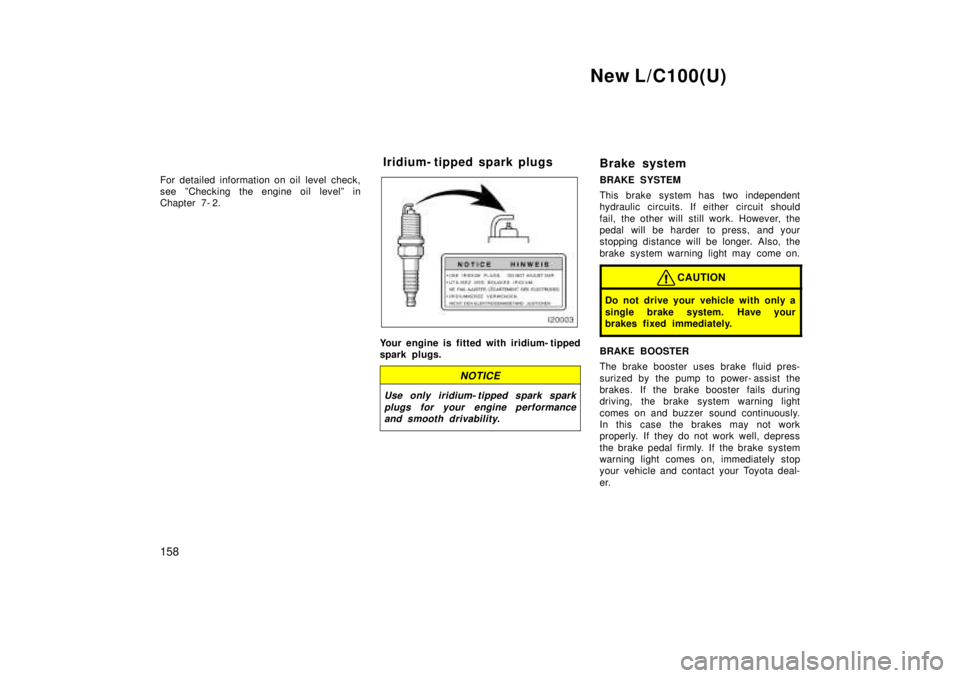1999 TOYOTA LAND CRUISER park assist
[x] Cancel search: park assistPage 89 of 202

New L/C100(U)97
(g) SRS Warning Light
This light will come on when the igni-
tion key is turned to the ºACCº or
ºONº position. After about 6 seconds,
the light will go off. This means the
system of the airbag and front seat belt
pretensioners are operating properly.
The warning light system monitors the air-
bag sensor assembly, front airbag sen-
sors, seat belt pretensioner assemblies,
inflators, warning light, interconnecting wir-
ing and power sources.
If either of the following conditions occurs,
this indicates a malfunction somewhere in
the parts monitored by the warning light
system. Contact your Toyota dealer as
soon as possible to service the vehicle.
� The light does not come on when the
ignition key is turned to the ºACCº or
ºONº position or remains on.
� The light comes on or flashes while
driving. (h) ºABSº Warning Light
This light warns that there is a problem
somewhere in your anti- lock brake sys-
tem.
If it comes on while you are driving, have
your vehicle checked by your Toyota deal-
er as soon as possible. However, it is
normal if the light goes out.
The light will come on when the ignition
key is turned to the ºONº position. After
a few seconds, the light will go off. There
may be the case that the ºABSº warning
light stays on for about 60 seconds after
the engine is started. It is normal if it
goes out after a while.
Depressing the brake pedal repeatedly
may turn on the light. It is normal if it
goes off after a few seconds.
When the ºABSº warning light is on (and
the brake system warning light is off), the
brake system operates conventionally but
anti- lock brake system is not assisting
brake performance so that the wheels can
lock- up during sudden braking or braking
on slippery road surfaces.
However, the anti- lock brake system does
not operate when the rear differential is
locked. It is normal operation for the
ºABSº warning light to be on at this time.
CAUTION
While the ºABSº warning light is on,
if either of the following conditions
occurs, immediately stop your vehicle
at a safe place and contact your
Toyota dealer. �
The brake system warning light
stays on even with the parking
brake being released.
� The brake system warning light and
buzzer come on.
In either case, the brakes may not
work properly. If they do not work
well, depress the brake pedal firmly.
(i) Open Door Warning Light
This light remains on until all the side
doors and back door are completely
closed.
(j) Unengaged ºParkº Warning Light
This light warns that the transmission
ºParkº mechanism is not engaged. If the
four- wheel drive control is in the ºNº posi-
tion while the selector lever is in the ºPº
position, the transmission will disengage
and the wheels will not lock.
Page 150 of 202

New L/C100(U)
158
For detailed information on oil level check,
see ºChecking the engine oil levelº in
Chapter 7- 2.
Your engine is fitted with iridium- tipped
spark plugs.
NOTICE
Use only iridium- tipped spark spark
plugs for your engine performanceand smooth drivability.
Brake system
BRAKE SYSTEM
This brake system has two independent
hydraulic circuits. If either circuit should
fail, the other will still work. However, the
pedal will be harder to press, and your
stopping distance will be longer. Also, the
brake system warning light may come on.
CAUTION
Do not drive your vehicle with only a
single brake system. Have your
brakes fixed immediately.
BRAKE BOOSTER
The brake booster uses brake fluid pres-
surized by the pump to power- assist the
brakes. If the brake booster fails during
driving, the brake system warning light
comes on and buzzer sound continuously.
In this case the brakes may not work
properly. If they do not work well, depress
the brake pedal firmly. If the brake system
warning light comes on, immediately stop
your vehicle and contact your Toyota deal-
er.
Iridium- tipped spark plugs
Page 160 of 202

New L/C100(U)
168
(b) Starting the engine
Before starting the engine, be sure to fol-
low the instructions in º(a) Before crank-
ingº.
Normal starting procedure
The multiport fuel injection system/sequen-
tial multiport fuel injection system in your
engine automatically controls the proper
air- fuel mixture for starting. You can start
a cold or hot engine as follows:
1. With your foot off the accelerator ped- al, crank the engine by turning the key
to ºSTARTº. Release it when the en-
gine starts.
2. After the engine runs for about 10 se- conds, you are ready to drive.
If the weather is below freezing, let the
engine warm up for a few minutes be-
fore driving.
If the engine stalls...
Simply restart it, using the correct proce-
dure given in normal starting.
If the engine will not start...
See ºIf your vehicle will not startº in Part 4.
NOTICE
�Do not crank for more than 30 se- conds at a time. This may overheatthe starter and wiring systems.
�Do not race a cold engine.
�If the engine becomes difficult tostart or stalls frequently, have the
engine checked immediately.
� Always slow down in gusty crosswinds.
This will allow you much better control.
� Drive slowly onto curbs and, if pos-
sible, at a right angle. Avoid driving
onto high, sharp- edged objects and
other road hazards. Failure to do so
can lead to severe tire damage result-
ing in tire bursts.
� When parking on a hill, turn the front
wheels until they touch the curb so
that the vehicle will not roll. Apply the
parking brake, and place the transmis-
sion in ºPº. If necessary, block the
wheels.
� Washing your vehicle or driving through
deep water may get the brakes wet. To
see whether they are wet, check that
there is no traffic near you, and then
press the pedal lightly. If you do not
feel a normal braking force, the brakes
are probably wet. To dry them, drive
the vehicle cautiously while lightly
pressing the brake pedal with the park-
ing brake pulled. If they still do not
work safely, pull to the side of the road
and call a Toyota dealer for assistance.
Tips for driving
in various conditions
Page 174 of 202

New L/C100(U)
202 �
High pressure water or steam is effec-
tive for cleaning the vehicle's underside
and wheel housings. Pay particular
attention to these areas as it is difficult
to see all the mud and dirt. It will do
more harm than good to simply wet the
mud and debris without removing them.
The lower edge of doors, rocker panels
and frame members have drain holes
which should not be allowed to clog
with dirt as trapped water in these
areas can cause corrosion.
� Wash the underside of the vehicle thor-
oughly when winter is over.
See ºWashing and waxing your Toyotaº for
more tips.
Check the condition of your vehicle's
paint and trim. If you find any chips or
scratches in the paint, touch them up im-
mediately to prevent corrosion from start-
ing. If the chips or scratches have gone
through the bare metal, have a qualified
body shop make the repair Check the interior of your vehicle.
Wa-
ter and dirt can accumulate under the
floor mats and could cause corrosion. Oc-
casionally check under the mats to make
sure the area is dry. Be particularly care-
ful when transporting chemicals, cleans-
ers, fertilizers, salt, etc.; these s hould be
transported in proper containers. If a spill
or leak should occur, immediately clean
and dry the area.
Use mud shields on your wheels. If you
drive on salted or gravel roads, mud
shields help protect your vehicle. Full- size
shields, which come as near to the ground
as possible, are the best. We recommend
that the fittings and the area where the
shields are installed be treated to resist
corrosion. Your Toyota dealer will be
happy to assist in supplying and insta lling
the shields if they are recommended for
your area.
Keep your vehicle in a well ventilated
garage or a roofed place. Do not park
your vehicle in a damp, poorly venti-
lated garage. If you wash your vehicle in
the garage, or if you drive it in covered
with water or snow, your garage may be
so damp it will cause corrosion. Even if
your garage is heated, a wet vehicle can
corrode if the ventilation is poor. Washing your Toyota
Keep your vehicle clean by regular
washing.
The following cases may cause weakness
to the paint or corrosion to the body and
parts. Wash your vehicle as soon as pos-
sible.
� When driving in a coastal area
� When driving on a road sprinkled with
antifreeze
� When having stuck of coal tar, tree
sap, bird droppings and carcass of an
insect
� When driving in the areas where there
is a lot of smoke, soot, dust, iron dust
and chemical substance
� When the vehicle becomes remarkably
dirty with dust and mud
Hand- washing your Toyota
Work in the shade and wait until the
vehicle body is not hot to the touch.
CAUTION
When cleaning under floor or chassis,
be careful not to injure your hands.
Washing and waxing your Toy- ota